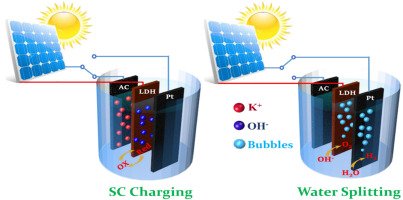Source: newatlas.com
This device developed at UCLA is a hybrid unit which combines a supercapacitor with a hydrogen fuel cell and it is powered by a solar cell. It is capable of storing electricity in the capacitor or it can use the energy to split water (electrolysis) and create hydrogen gas. Hydrogen gas is the fuel used by electric cars, it is an alternate way of storing electricity.
The device used a nickel cobalt iron layered double hydroxide (Ni-Co-Fe LDH) synthesized on a nickel foam as a substrate. This is used as the positive electrode and activated carbon is used as the negative electrode, together this makes up the unit that supply electric power to charge up the capacitor. For the oxygen evolution reaction (OER), the substrate (Ni-Co-Fe LDH) acts as a catalyst or to be more precise, an electrocatalyst, this is because the substrate uses the electricity to cause the substrate to separate the hydrogen and oxygen atoms from the water molecules.
Source: sciencedirect.com
This would make a welcome addition to a solar system. An off-grid system requires the use of batteries to store the power generated from the panels. A usual battery bank requires 16+ 12 volt batteries to store enough power for a home. Understand that this varies depending on house size, electrical appliances in the house, is the house heat gas or electric and many factors. The batteries used should be 'deep cycle' not regular car batteries, they come in different varieties like AGM (absorbent glass mat), maintenance free (you don't have to check water levels in the cells) and edison iron batteries (my preferred - but they are very expensive).
Another way to store the energy is by converting water into hydrogen gas and then instead of a large battery bank, you need a storage tank for the hydrogen. Compared to the battery bank the hydrogen tank requires less monitoring.



Hydrogen is going to take the place of many fuels!
I think so too.